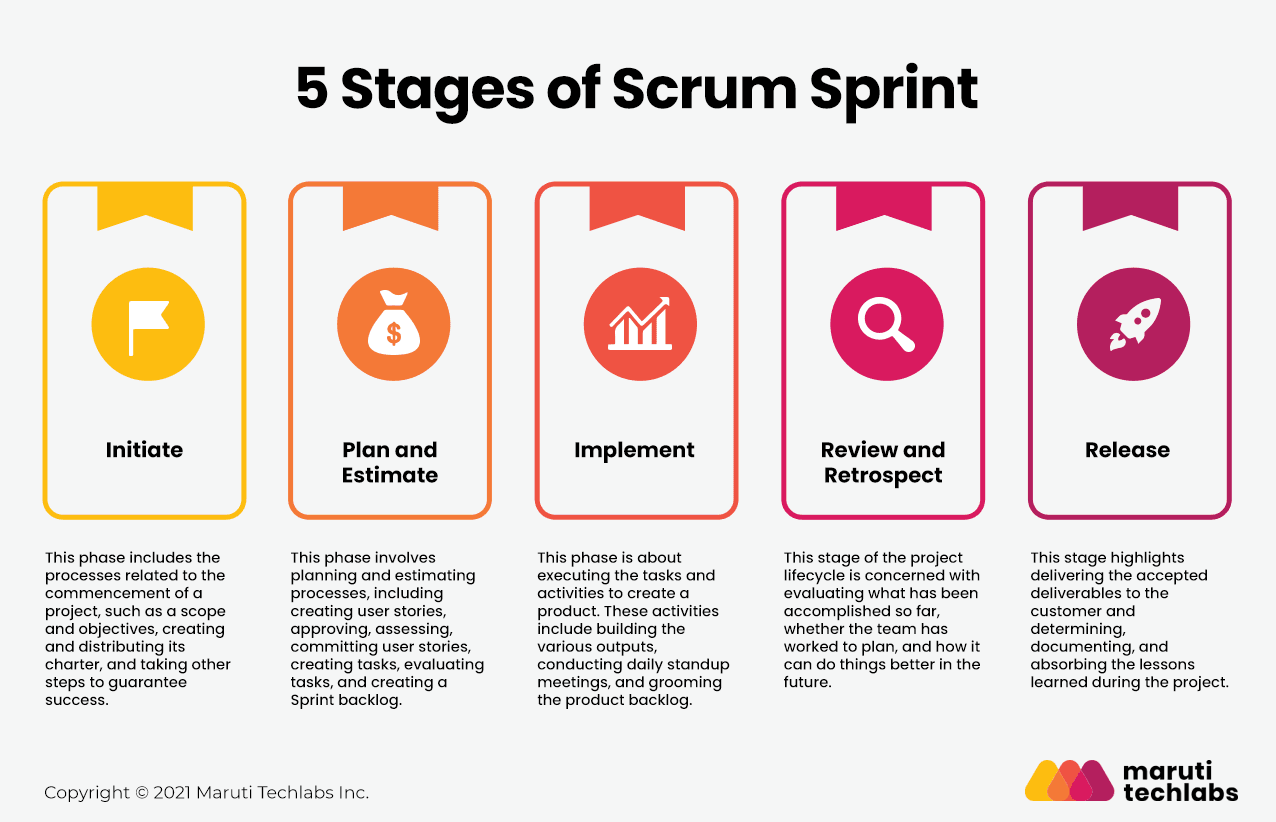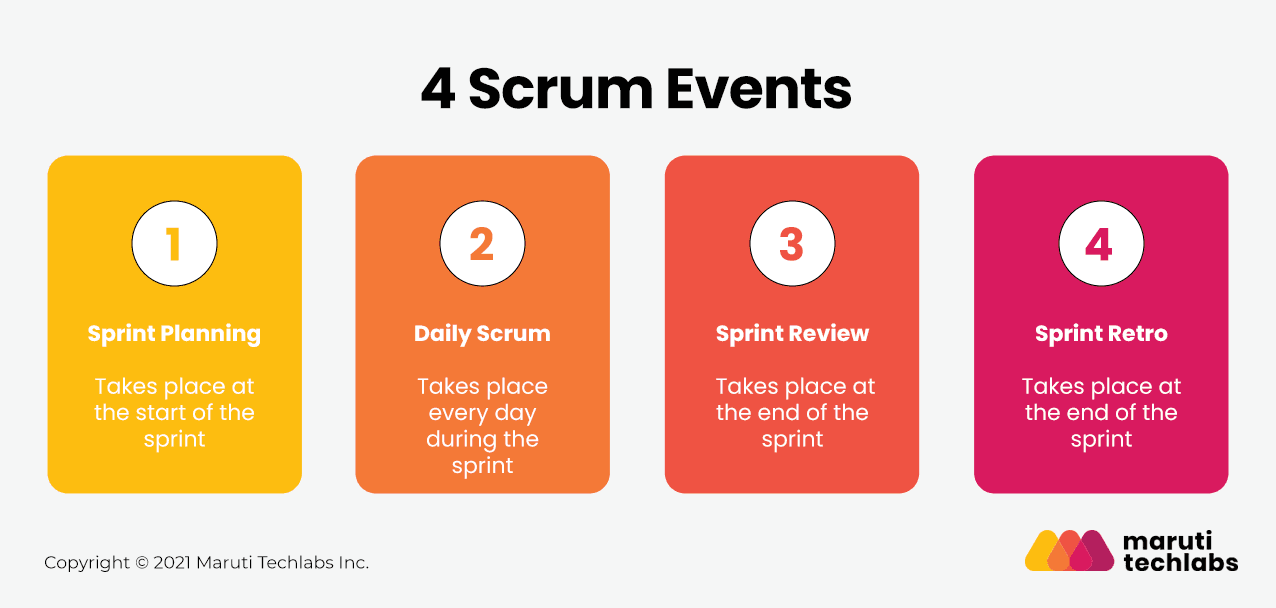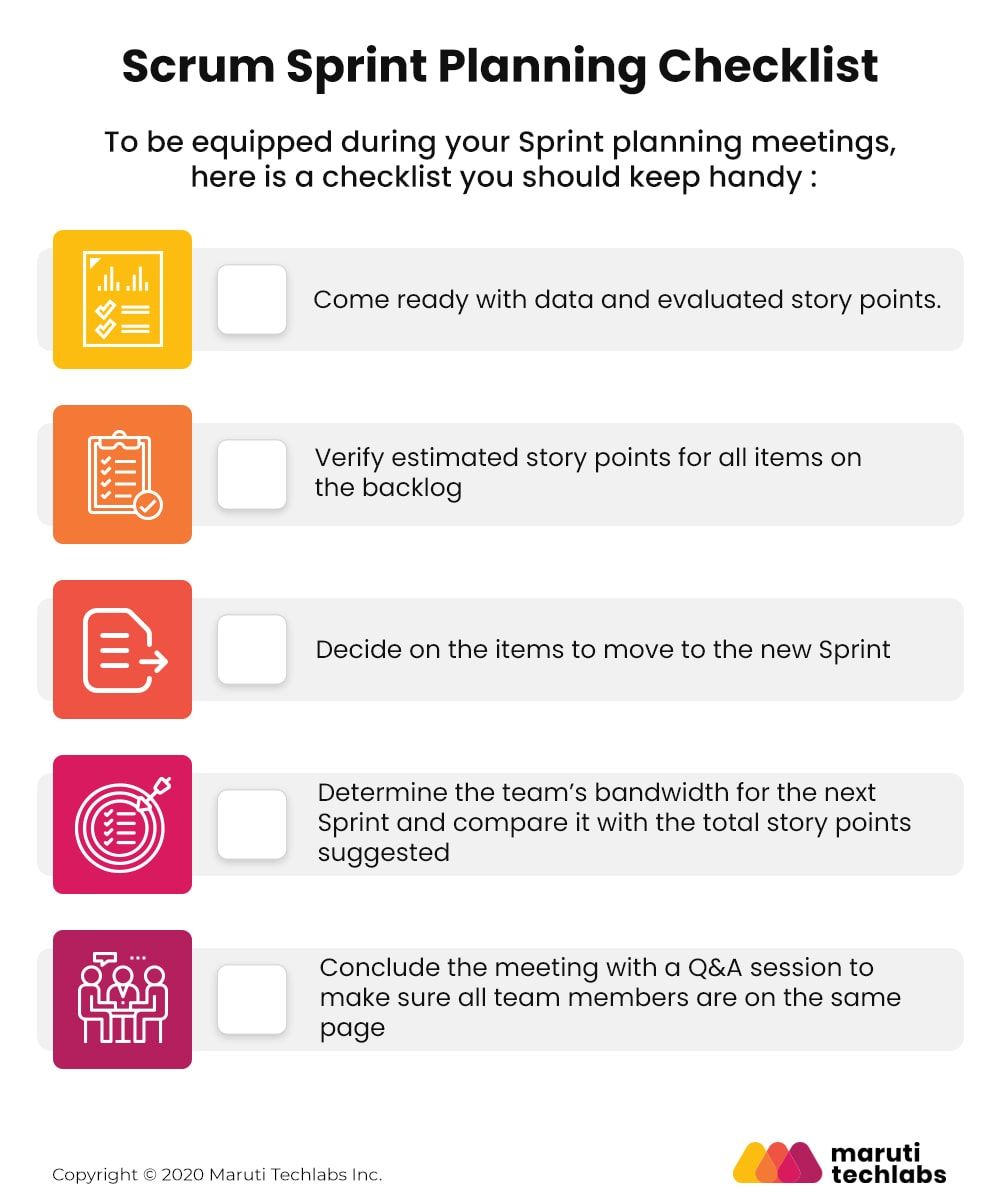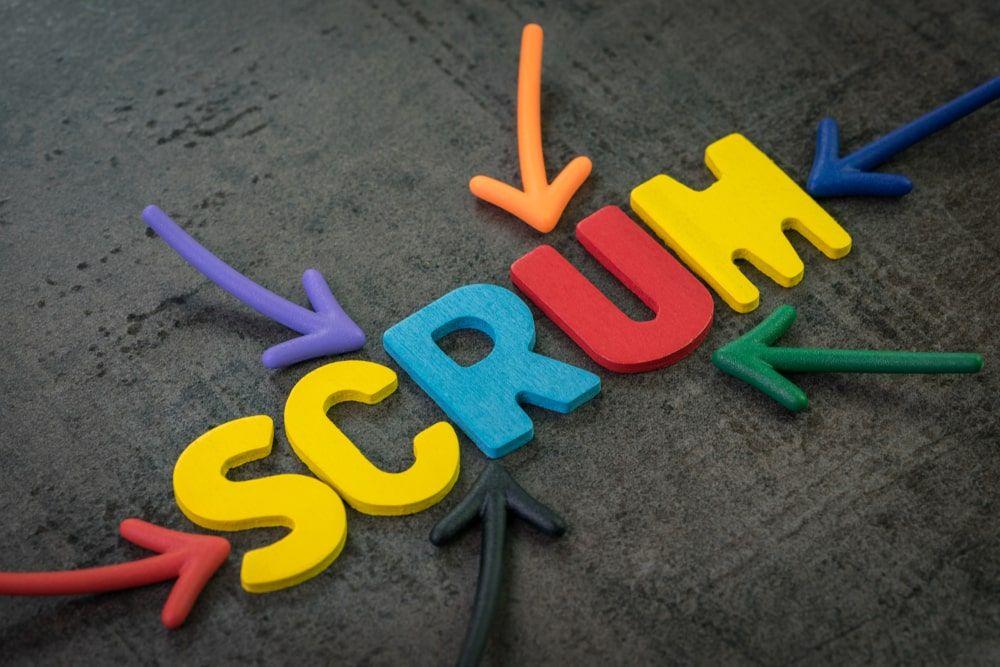Planning Your Scrum Sprint: A Step-by-Step Guide to Agile Success
Scrum is a popular Agile Framework for project management. It tends to be the most used Agile manifesto globally. Scrum brings flexibility, transparency, and creativity to Project Management. Even though it was initially invented to be used in Software Development, it’s currently used in every possible field to offer inventive goods & services to fulfill customers’ needs.
Hey there! This blog is almost about 2600+ words long & not everyone likes to read that much. We understand that.
This is precisely why we made a podcast on the topic. Mitul Makadia, CEO & Founder of Maruti Techlabs, talks to Bikshita Bhattacharyya about his Agile implementation, strategy, and process during the nascent stages of the company.
He walks us through the challenges he faced, how the business benefited from scaling Agile, and how important is the scrum master in making Agile a success at the organizational level. Here is a small snippet from that episode. Check it out!
Sprint is at the core of Scrum. A Sprint is a finite period that is allotted to create a working product. At the end of the Sprint, a review is conducted to demonstrate the working product. In this comprehensive blog post, we will take you through the different stages of Sprint, Scrum events, Sprint planning, as well as how you can be prepared to take part in your first Scrum Sprint.
Using Scrum the right way requires a fundamental understanding of Agile manifesto, Scrum Framework, and associated processes. We can achieve this by defining a small work product, conducting a Proof Of Concept, and planning for more extensive product/application development based on the results and lessons learned during PoC.
What is Sprint Planning?
In Scrum, every project is broken down into time blocks called Sprints. Sprints can vary in length but are usually 2-4 weeks long. A Sprint planning meeting is a periodic meeting that involves the entire team, including the Scrum Master, Scrum Product Manager, and Scrum Team. They meet to decide the scope of the current Sprint and which backlog items will be taken care of in the next Sprint. The Sprint planning Scrum event is a collective process that allows team members to say when work happens.
A successful Sprint planning session will give two critical strategic items:
- The Sprint goal: This includes a brief written summary of the team’s plans to achieve in the next Sprint.
- The Sprint backlog: The team has concurred to work on the list of stories and other product backlog items in the forthcoming Sprint.
5 Stages of Scrum Sprint

Sprints are the life of Scrum, where ideas are converted into value. Scrum processes tackle the specific activities and flow of a Scrum project. There are five stages of the Scrum Sprint planning as follows :
1. Initiate/ Pre-planning – This phase includes the processes related to the commencement of a project. It involves deciding on and setting the scope and objectives for the project, creating and distributing its charter, and taking other steps to guarantee success. Some of the processes include creating project vision, identifying Scrum Master and stakeholder(s), forming Scrum team, developing epic(s), and creating a prioritized product backlog.
2. Plan and Estimate -This phase involves planning and estimating processes, including creating user stories, approving, assessing, committing user stories, creating tasks, evaluating tasks, and creating a Sprint backlog.
3. Implement – This phase is about executing the tasks and activities to create a product. These activities include building the various outputs, conducting daily standup meetings, and grooming the product backlog.
4. Review and Retrospect/ Test – This stage of the project lifecycle is concerned with evaluating what has been accomplished so far, whether the team has worked to plan, and how it can do things better in the future.
5. Release – This stage highlights delivering the accepted deliverables to the customer and determining, documenting, and absorbing the lessons learned during the project.
A project has various phases. These include Preliminary Phase, Planning Phase, Design Phase, Implementation Phase, Testing Phase, Deployment Phase, and Support Phase. You can find the complete list of the 19 Scrum processes, as described in SBOK® Guide here.
Which are the 4 Scrum Events?
Scrum teams deliver products iteratively and progressively, ensuring a potentially valuable version of a working product is always available. Each increment of the development cycle produces a potentially helpful package that can be feedbacked on, which can then enhance all future versions until the desired end state is reached.
Primarily, Scrum consists of 4 formal events or phases :
- Sprint Planning
- Daily Scrum
- Sprint Review
- Sprint Retrospective

The Sprint, which is the primary activity in Scrum, lasts between 1 and 4 weeks.
1. Sprint Planning Meeting
This meeting initiates the Sprint by rendering the activities and work contained. The development teams make Sprint backlogs for the Sprint. The Product Owner and the Development Team then determine the team’s tasks within the subsequent Sprint. Team members take up various tasks based on the highest priority and who they feel can best serve them with the most excellent effectiveness. The Scrum Team may also invite other people to attend Sprint Planning to provide guidance.
2. Daily Scrum or Daily Standup
It is a roughly 15-minute, daily event that highlights the progress towards the Sprint goal. Each team member shares the latest progress on their work and identifies any potential challenges. This daily meeting aims to ensure all the team members are on the same page and their activities in sync.
Daily Scrums improve communications, identify barriers or challenges, promote quick decision-making, and thus eliminate the need for other meetings.
3. Sprint Review
The Sprint Review is conducted at the end of each Sprint. Its objective is to examine the result of the Sprint and discuss the goals achieved. This review meeting also gives the stakeholders a chance to provide feedback and suggestions about the product.
The Sprint Review is the second last event of the Sprint. It is timeboxed to a limit of four hours for a one-month Sprint. For shorter Sprints, the event is generally faster.
4. Sprint Retrospective
The Retrospective Meeting, also referred to as the RnR by Scrum teams, allows teams to assess their achievements at the end of a Sprint. It encourages open conversation about the successes and failures and identifies ways to strengthen activities during upcoming Sprints. The purpose of Sprint Retrospective is to plan ways to enhance both quality and efficiency.
The Sprint Retrospective ends the Sprint. It is timeboxed to the utmost of three hours for a one-month Sprint.
Scrum Sprint Planning – Why, What & How

The three questions about Sprint planning events:
1. Why?
Every Sprint is an investment. Both money and time are invested, which usually can’t be taken back. What’s spent is gone. Scrum demands that we have an idea of the price of these investments. We draft a Sprint objective to answer this question:
- Why do we invest in this product or service?
- What result or impact are we looking to make with this investment?
We seek to answer this why-question in the Sprint goal.
2. What?
Now that we understand the purpose – the motive for running this Sprint – one must come up with the best idea of what to do to get there. It usually means we select backlog items that we think will realize the value we’re going for, help us achieve the Sprint goal. Hence, we come up with a prediction of what we want to do to achieve the result we’re investing in.
3. How?
How do we get the work done? Where do we need to research, work together, design, re-use, or throw out? When there are multiple unknowns, planning to a high level of detail usually results in a lot of waste.
Scrum Sprint Planning: Things To Do Before Your First Sprint
Before a Sprint commences, some planning is necessary. For your first Sprint to be a win, there are many measures you should take before you get started.
Sprint Planning: This event is the Scrum Team’s first stride towards Sprint success. The Product Owner talks about the product backlog with the Development Team during this ceremony.
The Scrum Master assists the Scrum Team’s meeting, during which effort or story point estimates are done. The product backlog must include all the details for analysis (e.g., timeframes, specific steps, for what for which customer group, etc.) And the Product Owner must answer any questions that may arise regarding its content before the estimation.
Here are the things you must cover before your first Sprint:
1. Internalize the Scrum values as a team
Imbibe the Scrum values to ensure your team can take control and organize themselves successfully.
If the team members can communicate well, there will be no need to take charge since everyone knows what they should do.
2. Create a Project Roadmap
The product owner should work with the appropriate stakeholders to discuss high-level versions of end goals, short-term goals, and a flexible timeline to work around the project’s progress.
Note that a significant assessment of Agile methodology is preparation and flexibility. Your roadmap should be prepared as the project progresses, so it can be continuously adjusted as your business changes and grows, so it doesn’t need to be complete or flawless right away.
3. Collaborate with Stakeholders on Product Backlog
As a project manager, you need to work with your team and the shareholders to: add, review, and prioritize product backlog items.
Outcome: The Development Team’s work can be decided during the Sprint — the Sprint goal. It’s an expansion of complete work, and everyone should feel confident about the dedication. There might be a lot of negotiation that occurs during this ceremony.
Scrum Sprint Planning Checklist

To be equipped during your Sprint planning meetings, here is a checklist you should keep handy :
- Come ready with data and evaluated story points.
- Verify estimated story points for all items on the backlog
- Decide on the items to move to the new Sprint.
- Determine the team’s bandwidth for the next Sprint and compare it with the total story points suggested
- Conclude the meeting with Q&A session to make sure all team members are on the same page
Advantages of Sprint Planning
- Establishes a Communication Platform for the Scrum Team
When the Sprint Planning event occurs, the team members can recognize their ability and dependencies to achieve the goals effectively. So, they can then plan their work to achieve those goals during their ongoing Sprint effectively.
- Helps in Prioritizing the Deliverable
The product owner is responsible for choosing which items from the backlog are implemented in a Sprint. The product owner prioritizes the importance of each item and may also cut things down, in length or entirely if needed, making them more “doable” for a given Sprint. This way, only the essential features of the product get completed during early development.
- Prevents Scrum Team Burnout
The team will set its targets clearly since developers will select the goals according to their estimations and capabilities. This way, there won’t need to be any involvement of a third party that could set unachievable goals for the Scrum Team.
Disadvantages of Sprint Planning
- Lackluster Calculations can Lead to Failures
As tasks during the current Sprint will be counted based on estimates from developers, the ability to reach a Sprint goal can be hindered by unreliable and wrong estimations.
- Appropriate Knowledge of Scrum is Mandatory to Carry Out Sprint Planning
For a successful Sprint Planning session, the team should be highly informed and aware of the various Scrum frameworks. Lack of proper knowledge can cause Sprint Planning to be unsuccessful.
Scrum Artifacts Explained

Scrum’s artifacts represent work or value. They are information that a scrum team and stakeholders use to outline the product being developed, actions required to produce it, and the actions performed during the project. Scrum artifacts are designed to maximize the transparency of key information.
Scrum Artifacts such as the Sprint backlog and product backlog contain a commitment that defines how they will provide information. For example, the product backlog has the project’s goal.
These commitments exist to strengthen the Scrum values for the Scrum Team and its stakeholders.
1. Product Backlog
The product backlog lists prioritized features, enhancements, bug fixes, tasks, or work requirements needed to build the end product. The primary source of requirements is compiled from input sources like customer support, competitor analysis, market demands, and general business analysis. The Product Backlog is a highly visible and “live” artifact at the heart of the Scrum framework accessible for all the projects. It is updated on-demand as new data is available.
2. The Sprint Backlog
The Sprint Backlog covers a list of tasks that the Scrum team has to achieve by the end of the Sprint. The development teams make Sprint backlogs to plan outputs and solutions for upcoming increments and detail the work needed to create the increment. It is a planned process containing complete information that helps to clearly understand the changes carried out in the development during the Daily Scrum.
Sprint backlogs are created by picking a task from the product backlog and splitting that task into smaller, actionable Sprint items. If a team does not have the bandwidth to deliver all the Sprint tasks, the remaining tasks will stand by in the Sprint backlog for a later Sprint.
3. The Product Increment
The word “Increment” itself describes the increase to the next stage. The increment is a step in the direction of a goal or vision. The Product Increment comprises a list of Product Backlog items completed during the Sprint and the former Sprints. By the end of Sprint, the Scrum team should conclude every backlog item.
An Increment is the customer deliverables that were produced by completing product backlog tasks during a Sprint. In a nutshell, there is always one for every Sprint in a single increment. And an increment is determined during the scrum planning phase. An increment happens if the team chooses to release it to the customer. If needed, product increments can complement CI/CD tracking and version rollback.
Did you find the video snippet on How does a scrum master ensure that everyone is on the same page? to be insightful? We have a ~22 min video where Mitul Makadia gets into the weeds, and we discuss about Implementing & Scaling Agile to streamline Software Development. Take a look –
Conclusion
If you’re new to Scrum, you might be wondering what happens during a Scrum Sprint. In this blog, we have covered the essential topics related to Scrum Sprint so you can see how the process works. It can be a significant change from how you might have done work before, so it’s helpful to understand the Scrum Sprint stages, various scrum events, Sprint planning, and checklist, as well as the pros and cons of Sprint planning.
The methodology of agile development has proven to be a winning formula for product development projects. It has allowed companies to successfully deliver their software products on time, meeting all objectives without sacrificing quality.
If you want to do a Scrum sprint but don't have enough resources, you can find an Agile offshore development team. Having experts in managing Agile demands and capacity on your team will help with Sprint planning.
By staying flexible, adaptable, and nimble, Maruti Techlabs has been able to help companies across all industries achieve their product development goals through Agile methodology and Scrum Sprints.
As a product development partner that has worked remotely with more than 90% of its clientele, it is imperative for us to define Scrum guidelines and processes with our clients beforehand for a successful partnership. The Scrum methodology and its various stages are the first steps we take before deploying teams. At Maruti Techlabs, we believe it is imperative to lay a solid groundwork for an effective partnership between remote development teams at our side and the client-side. It is where we make utmost use of Scrum guidelines and Agile frameworks.
If you’d like to learn more about how this could benefit you, connect with our team for a free consultation and see how we can help you consistently deliver and hit Sprint goals with our exceptional product development services.





















